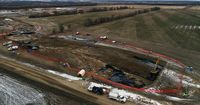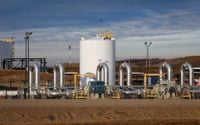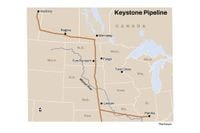FORT RANSOM, N.D. — The Keystone Pipeline system was shut down on the morning of April 8, 2025, following a significant oil spill in southeastern North Dakota that has raised concerns about environmental safety and infrastructure integrity. The incident occurred after a pipeline employee heard a "mechanical bang" at approximately 7:44 a.m. and promptly reported the issue, leading to the pipeline's closure within two minutes, according to Bill Suess, manager of the spill investigation program at the North Dakota Department of Environmental Quality.
The pipeline rupture, which took place north of Fort Ransom, has resulted in a spill that is currently confined to an agricultural field located about 300 yards south of the pump station. Fortunately, no people or structures have been affected, and a nearby stream has been isolated as a precaution, although it has not been impacted by the spill. Emergency crews have been dispatched to the scene to manage the situation and assess the extent of the damage.
As of now, the exact volume of crude oil that has spilled remains undetermined. Suess noted that while there was a "fairly good volume" of oil involved, he did not anticipate it would be as catastrophic as previous spills the pipeline has experienced. This incident marks another chapter in the ongoing saga of the Keystone Pipeline, which has faced scrutiny and criticism over its environmental impact since its inception.
The Keystone Pipeline, which stretches approximately 2,687 miles, has been operational since 2010 and is designed to transport crude oil from Alberta, Canada, to U.S. refineries. In 2024, it was reported that the pipeline carried about 626,000 barrels of crude oil per day. The infrastructure was previously managed by TC Energy, which has been at the center of several high-profile controversies regarding its environmental safety record.
In light of the recent spill, the management of the pipeline has shifted to South Bow, a company that was spun off from TC Energy in October 2024. South Bow confirmed that the shutdown was initiated after their control center's leak detection systems identified a pressure drop in the pipeline. "The affected segment has been isolated, and operations and containment resources have been mobilized to site," said Solomiya Lyaskovska, a spokeswoman for South Bow, emphasizing the company's commitment to safety and environmental protection.
Historically, the Keystone Pipeline has been plagued by several spills and leaks. For instance, in December 2022, over 500,000 gallons of crude oil spilled in Washington County, Kansas, due to "bending stress" on the pipe and a "weld flaw," according to TC Energy. Additionally, an October 2019 leak in Edinburg, North Dakota, resulted in approximately 383,000 gallons of crude oil contaminating half an acre of wetland. These incidents have fueled ongoing debates about the pipeline's safety and the potential risks associated with its operation.
The recent spill comes at a time when discussions about the future of the Keystone XL project have resurfaced. Just weeks prior, former President Donald Trump called for the revival of the controversial Keystone XL pipeline, which was intended to transport 800,000 barrels of Canadian heavy crude to U.S. refineries. The Biden administration canceled the project, citing environmental concerns and a shift towards greener energy sources. However, a 2022 poll conducted by Maru Public Opinion indicated that 71% of Americans favored the idea of restarting the Keystone XL project, particularly after the U.S. imposed a ban on Russian energy imports following the invasion of Ukraine.
The Keystone XL project, which would have significantly increased the pipeline's capacity, faced heavy opposition from environmentalists, Indigenous groups, and various advocacy organizations. Critics argue that such projects exacerbate climate change and pose significant risks to local ecosystems. The Biden administration's decision to terminate the project has been a point of contention, with proponents arguing that it could have provided a secure energy source for the U.S.
As investigations into the latest spill continue, the future of the Keystone Pipeline remains uncertain. Bill Suess stated that a timeline for when the pipeline might resume operations is not available, as it hinges on understanding the cause of the incident and the necessary repairs. "It all depends on what caused the incident and what is needed to repair it," he noted.
The environmental implications of the Keystone Pipeline are significant, particularly in light of the ongoing climate crisis. The U.S. Environmental Protection Agency has previously criticized the pipeline for neglecting concerns related to oil spill response plans and greenhouse gas emissions. As the nation grapples with the dual challenges of energy security and environmental sustainability, incidents like this spill raise critical questions about the balance between infrastructure development and ecological preservation.
In summary, the recent spill at the Keystone Pipeline near Fort Ransom, North Dakota, highlights ongoing concerns regarding the safety and environmental impact of oil transport systems. As investigations proceed and discussions about the future of the Keystone XL project continue, the incident serves as a reminder of the complexities involved in managing energy resources in an environmentally conscious manner.







